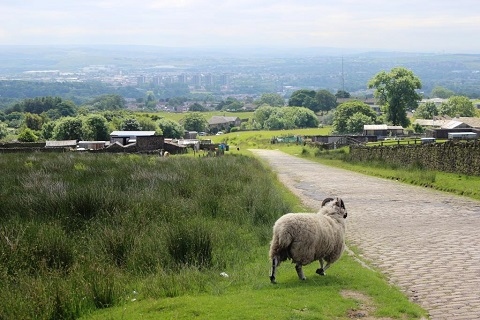Catley Lane Head to receive conservation status
Date published: 08 December 2017

A view from the Cotton Famine Road over Catley Lane Head
Rochdale Township Committee approved conservation status for Catley Lane Head at Wednesday’s (6 December) Township meeting.
Conservation area status gives a place special protection in planning law, meaning any application to develop or demolish buildings in the area will need to be considered carefully to ensure it doesn’t damage its historic character.
The rural hamlet, the gateway to Rooley Moor, contains a number of historic buildings, including the grade II listed Smallshaw Farm, which was built in 1622.
The conservation area includes Brownhill Farm in the south, the Grade II listed Smallshaw Farm in the east, a significant section of Rooley Moor Road up to Knacks Lane in the north-west.
Rooley Moor Road, a former pack horse route splitting the hamlet in two, was likely constructed at some point during the 13th century to provide a route across the moors from Spotland to Bacup in Rossendale.
The conservation area also includes three ponds, a stream, features such as setted roads and dry-stone walls, and a number of vernacular houses. A historic shop has since been converted to residential use, retaining the street sign, post box and stone detail. Other historic details can be found on buildings, including date stones and remains of a boot scraper.
It also takes in part of the famous Cotton Famine Road, so-called because Rochdale's cotton workers sided with the African slaves, who picked cotton in the US, in support of President Abraham Lincoln’s pledge to abolish slavery. This was despite the fact that the Union blockade of Confederate ports led to a shortage of cotton supplies coming into Rochdale, causing the ‘cotton famine’ of the 1860s, which starved thousands of men and women of their livelihoods.
A public works programme, which included work on the cotton famine road, was created to keep the impoverished cotton mill workers employed during this difficult time.
The historic stone way at the top of Rooley Moor Road became the subject of a BBC Two series in November 2016.
https://www.rochdaleonline.co.uk/news-features/2/news-headlines/106431/cotton-famine-road-in-bbc-documentary
The first record of housing in the Catley Lane Head area dates from the 16th century, but many houses that are still in existence today were built between the 17th to the 20th century. Historically the population consisted of miners, quarrymen, and factory operatives employed in the Smallshaw Mill, a cotton mill built by Jacob Tweedale & Sons in the 19th century. During the time the mill operated, there were two active coal pits in the area.
From 1845 onwards, a Sunday School was active in the hamlet, then known as Lanehead. A new chapel was built in 1857 and enlarged with an additional storey in 1872.
The area faced economic decline during the late 19th and early 20th centuries and some public buildings, including the chapel, have been demolished. It is difficult to give exact dates for these key transformations in the hamlet due to a lack of records, but many of these developments can be read from historic maps.
Do you have a story for us?
Let us know by emailing news@rochdaleonline.co.uk
All contact will be treated in confidence.
Most Viewed News Stories
- 1Royton haulage firm fined after Rochdale dad went to work and didn’t come home
- 2Six men arrested in Rochdale child exploitation investigation
- 3Rochdale church to host Camerados public living room
- 4Suspended council candidate was ‘politically naive’ for appearing in George Galloway video, leader...
- 530 years of the GEM Appeal, a Rochdale-founded charity that has raised millions and changed the...
To contact the Rochdale Online news desk, email news@rochdaleonline.co.uk or visit our news submission page.
To get the latest news on your desktop or mobile, follow Rochdale Online on Twitter and Facebook.


